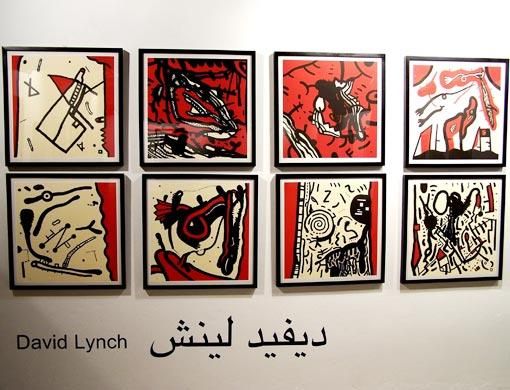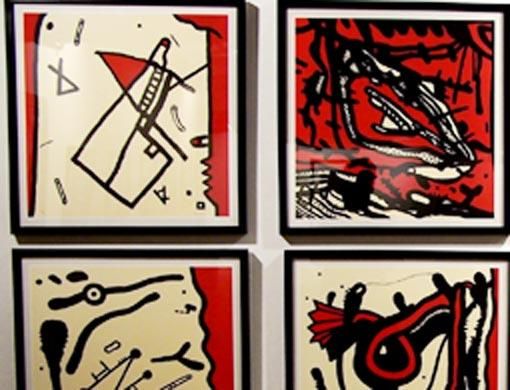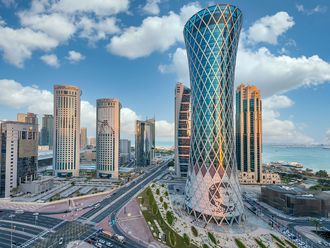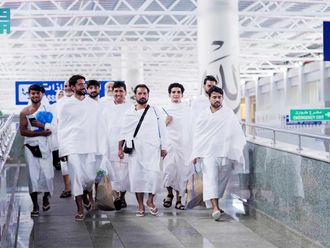The master of the macabre arts has brought his works to the middle east
Arguably the most memorable scene in the works of macabre director David Lynch, is the dream sequence at the end of Twin Peaks's episode three.
FBI Agent Dale Cooper, searching for the murderer of Laura Palmer, goes to sleep and finds himself in an eerie room with a dwarf that speaks backward, a woman who resembles the murder victim and the shadow of a giant unseen bird. Gloomy jazz plays in the background.
They are surrounded by stridently red curtains. Beige and black stripes zigzag across the floor like comic book thunder.
It is a scene as unforgettable as it is perplexing.
You would have seen something similar this week if you were walking down, of all places, the Jordanian capital Amman and you came upon the Zara Shopping Centre.
Up an escalator past clothes boutiques and a movie theatre, you would find an otherwise pale looking hall that had been converted into a picture gallery full of glamorous and exotic photographs (including the series that features Steve McCurry's iconic Afghan Girl).
And at the back of this venue, you would find a row of 12 simply framed lithographs, each about 50cm by 50cm.
On a small plaque next to the lithographs you would read that they are by the three-time-Academy Award nominated, French Legion of Honour winning cult director of Blue Velvet, Elephant Man, Mulholland Drive and Dune. David Lynch himself.
Subconscious musings
The pictures are weird, strangely aggressive patches and blobs that look like something halfway between Salvador Dali and a Mambo T-shirt. The shapes are fluid, almost shifting. Standing before them, you sometimes notice something recognisable from the corner of your eye – a cat, a door, spilled guts but when you turn your head it disappears.
It takes a while before you realise not only the macabre feeling in your stomach, but also the colours are exactly the same as the dark subconscious musings in the Twin
Peaks's dream sequence.
David Lynch, the man whose movies many would consider the closest thing cinema has come to the theatre of the absurd, also has a lesser known career as graphic artist
and painter.
This aspect of him is currently on show for the first time in the Middle East as part of the Jordan Festival, a month long event that features such headline grabbers as a Mika, Diana Krall, Placido Domingo and Elissa.
One of the lesser advertised, but no less exciting events, is the exhibition of Lynch's work from a series called the Paris Suite.
These lithographs are an extention of the film work of a man whose movies have notoriously featured an asthmatic pervert, body snatching ghosts, a horrifyingly unfunny
sitcom starring bunny rabbits and the movie debut of Marilyn Manson.
Climate of unease
The exhibition notes pay tribute to Lynch's macabre brilliance. The collection, it says, is"so singular as to elude classification. [Lynch's work] has an uncanny knack for
pointing a finger at that which is disquieting, creating a palpable but … delectable climate of unease".
The exhibition's curator, Cyril Pigot, says Lynch"takes small pieces of human body, which allow our eyes to recreate different way of images and situations. Mixing different
point of views, he recreate a depth and a certain perspective".
Should you read up about Lynch's second life as a graphic artist, you will find a whole new side to the director. In the years 1983 to 1992 he drew a regular comic strip called
The Angriest Dog in the World, which appeared in several offbeat publications, including the Village Voice. And he has even designed a range of furniture.
The furniture at least looks normal.
Sad faces
David Lynch's works share an Amman venue with the pictures of Steve McCurry, the National Geographic photographer whose Afghan Girl, a picture of a shy, green-eyed Afghani girl in a red headscarf, has been voted the most recognised picture in the history of the magazine.
McCurry's work, which has also been collected in the book Looking East, show Asian societies both happy and distraught, but by far the most haunting are the portraits of
poor Afghani peasants.
The same Afghan girl (originally photographed in a refugee camp in 1984) is shown in the Amman exhibition in pictures from the same series her expression softer than
on the famous picture, her scarf drawn over her face, suggesting a shy smile.
And on a different picture, taken in 2002, we see another young girl from Afghanistan, this one's face looking eerily empty, wrapped in a blue headscarf. It's a different war,
but her expression looks sadly familiar.
The Jordan Festival is an arts and entertainment extravaganza that runs from July 9 to August 9. Among the international acts that it has put on the stage over the past
month, were Mika (performing next to the Dead Sea), Diana Krall (who sang among the ruins of the Amman citadel) and Placido Domingo (who performed at the Roman theatre, Jerash). It also staged such Middle Eastern superstars as Elissa and Abdala Irwaished.
Pieces from David Lynch's Paris Suite will be on exhibition at the Zara Centre, Amman, until Saturday.














